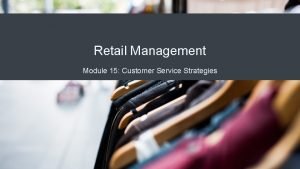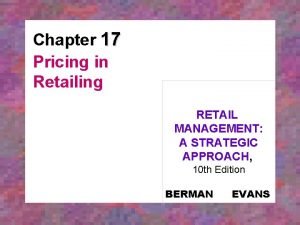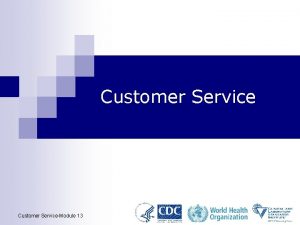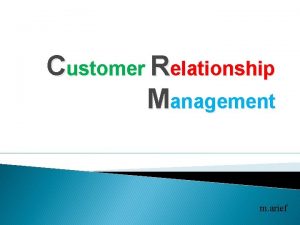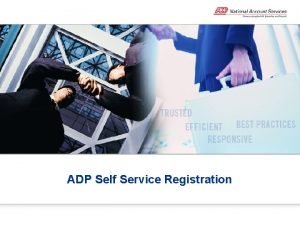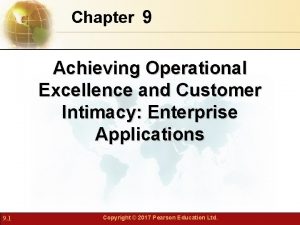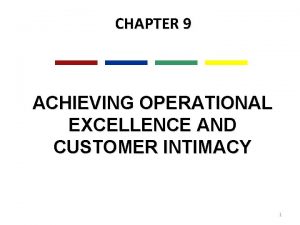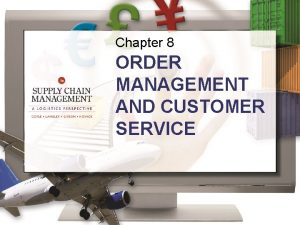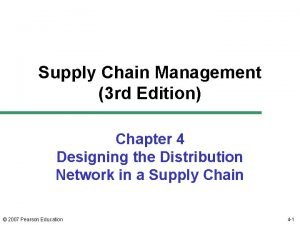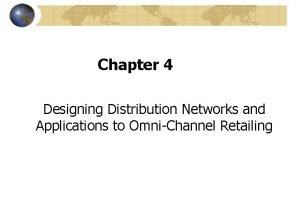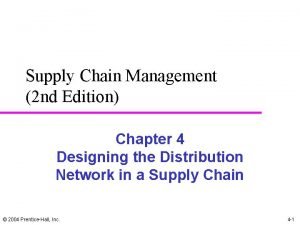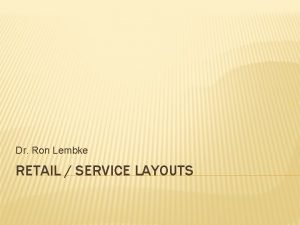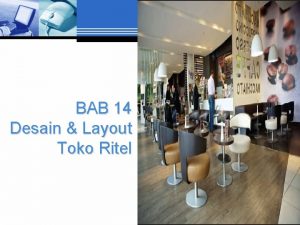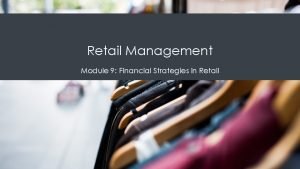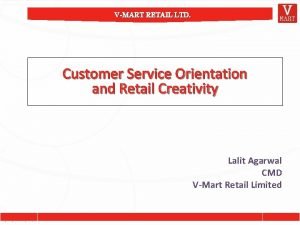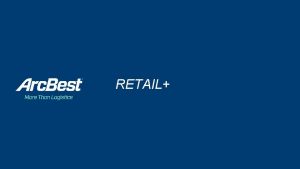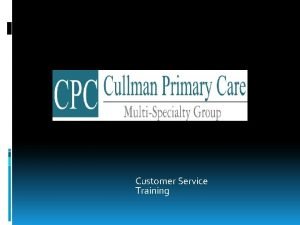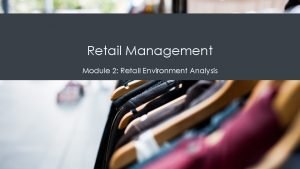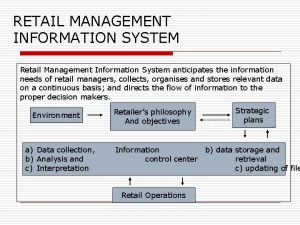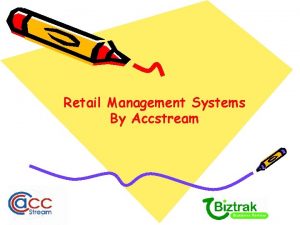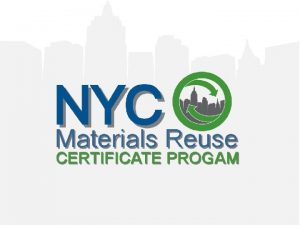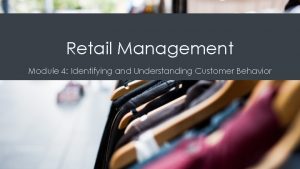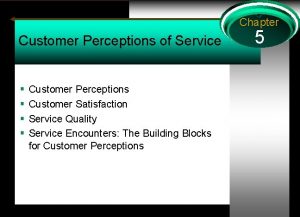Retail Management Module 15 Customer Service Strategies Customer






















- Slides: 22

Retail Management Module 15: Customer Service Strategies

Customer Service Strategies

Learning Outcomes: Customer Service Strategies 15. 1 Identify how retailers can use excellent customer service as a differentiation tool • 15. 1. 1 Define customer service • 15. 1. 2 Discuss the value of customer profiles in retail customer service • 15. 1. 3 Categorize services offered by retailers as basic or luxury • 15. 1. 4 Compare and contrast personalized and standardized service

Customer Service Definition: “The assistance and advice provided by a company to those people who buy or use its products or services” Definition varies widely depending on understanding on basic terms “customer” and “service” Regardless of definition, it is dependent on act of meeting customer wants and needs

Activity • Customer service is a core component of the retail industry. Write a short statement of less than five sentences summarizing how you would define quality customer service. Think of this as something you might say during a job interview if you were asked what you value as good customer service.

Customer Profiles Internal customers: employees, vendors, business stakeholders External customers: follow the 5 Ws • • • Who Why What Where When

Offered Services • • • Customer service, including complimentary services offered, is one way that retailers differentiate themselves in a crowded marketplace Customer service can be a source of enduring brand business value The key is to understand your customer’s value proposition and deliver a relevant level of service.

Personalized vs. Standardized Service Standardization: • • Promotes reliability, effectiveness, trust, improved economic efficiency Often employed in store layouts, purchasing, labeling, branding Personalized Service: • • Method of adding value to customer choice Often relies on technology to more effectively and efficiently implement new range of services

Customer Evaluation Process

Learning Outcomes: Customer Evaluation Process 15. 2 Explain the key components of the customer evaluation process • 15. 2. 1 Define customer perception and customer expectation • 15. 2. 2 Describe the main characteristics that affect service quality perceptions • 15. 2. 3 Explain the role of customer expectations in determining the value of service perceived

Perception vs. Expectation • • Customer satisfaction is typically defined as the feeling that a person experiences when an offering meets his or her expectations Some companies evaluate their salespeople based on how well they satisfy their customers Two critical ways to improve customer satisfaction • • The first is to establish appropriate expectations in the minds of customers. The second is to deliver on those expectations.

Service Quality Perceptions Effective customer satisfaction measures have several components: • • • Customer’s expectations Whether the organization performed well enough to meet them The degree of satisfaction

Customer Expectations Customers will complain, though, no matter how hard firms try to meet or exceed their expectations A complaint record should reflect the main reason an offering failed. Typically, the failure can be attributed to one (or more) of the following four gaps (Levy & Weitz, 2009): 1. The communication gap. Overstating the offering’s performance level, thereby creating unrealistic expectations on the part of customers. 2. The knowledge gap. Not understanding the customer’s expectations or needs, which then leads a company to create a product that disappoints the customer. 3. The standards gap. Setting performance standards that are too low despite what is known about the customers’ requirements. 4. The delivery gap. Failing to meet the performance standards established for an offering.

Gap Model of Service Quality

Learning Outcomes: Gap Model of Service Quality 15. 3 Discuss the gap model of service quality • 15. 3. 1 Outline how a retailer can close the customer expectations and management perceptions gap • 15. 3. 2 Outline how a retailer can close the management perceptions and quality specs gap • 15. 3. 3 Outline how a retailer can close the quality specs and service delivery gap • 15. 3. 4 Outline how a retailer can close the service delivery and communications gap • 15. 3. 5 Outline how a retailer can close the actual performance and perceived service gap

Gap 1: Customer Expectation vs. Management Perception Market research: conducted to understand whethere would be any demand for the product Communication channels: the fewer layers between management and customer contact, the more likely customer preferences will be incorporated

Gap 2: Management Perception vs. Quality Specifications Management may have an accurate understanding of customer expectations but that understanding hasn’t been effectively implemented as operating policy ● ● Clearly articulate service levels and business (i. e. , budget) assumptions Develop, communicate and train to specific customer service standards Factor service level performance into evaluations for all related personnel Measure performance and adjust resources as required to meet service level objectives ● Monitor industry service level standards and update policy as appropriate

Gap 3: Quality Specifications vs. Service Delivery • In a performance gap situation, the issue is generally not the lack of specific service policies but a failure to consistently and reliably meet those service expectations • Developing a well-structured onboarding process, providing product/service training and cultivating a customer-centric team environment can help new service employees get up to speed with a minimum of stress • Validate service quality expectations and align people, processes and culture to support those goals

Gap 4: Service Delivery vs. External Communications Quality, responsiveness and price are all important elements. What’s most important, however, is keeping your word. That will keep customers satisfied, and ensure that you keep your customers. ● Review communications across all touch-points, including digital (email, website, social media and partner sites), print, and on-premise materials, to ensure accuracy and consistency ● Implement a “reality check” review and approval process for new campaigns and updates. ● Conduct mock customer interactions and listen in and provide coaching on point-ofcontact conversations to ensure services are being represented realistically ● Incorporate employee input and customer reviews to make advertising real. Similarly, incorporating actual employees and customers in advertising puts a real face on the business.

Gap 5: Actual Performance vs. Perceived Service Gap • • • Occur due to service issues from gaps 1 -4 or can reflect an error in the customer’s judgement of the service received The customer’s perception is influenced by a range of factors including personal experience and needs, advertising and word of mouth Obtaining customer feedback is the key to identifying the root cause(s) – that is, the underlying service gap(s) – and, ultimately, closing the Customer gap

Practice Question • What are the five components of the gap model of customer service?

Quick Review • • • Define customer service Discuss the value of customer profiles in retail customer service Categorize services offered by retailers as basic or luxury Compare and contrast personalized and standardized service Define customer perception and customer expectation Describe the main characteristics that affect service quality perceptions Explain the role of customer expectations in determining the value of service perceived Outline how a retailer can close the customer expectations and management perceptions gap Outline how a retailer can close the management perceptions and quality specs gap Outline how a retailer can close the quality specs and service delivery gap Outline how a retailer can close the service delivery and communications gap Outline how a retailer can close the actual performance and perceived service gap
 Gap model in retail management
Gap model in retail management Retail communication methods
Retail communication methods Assess human resource requirements of a retail organization
Assess human resource requirements of a retail organization Pricing in retailing
Pricing in retailing Kvi pricing strategy
Kvi pricing strategy Retail strategic planning
Retail strategic planning Customer service module
Customer service module Pengertian customer relationship
Pengertian customer relationship Customer management strategies
Customer management strategies Adp self pay
Adp self pay Customer relationship management and customer intimacy
Customer relationship management and customer intimacy Customer relationship management and customer intimacy
Customer relationship management and customer intimacy Intimacy
Intimacy C device module module 1
C device module module 1 Order management & customer service relationship concept
Order management & customer service relationship concept Resident customer service
Resident customer service Drop shipping
Drop shipping Retail storage with customer pickup
Retail storage with customer pickup Distributor storage with carrier delivery
Distributor storage with carrier delivery Retail storage with customer pickup
Retail storage with customer pickup Distributor storage with carrier delivery example
Distributor storage with carrier delivery example Retail service layout
Retail service layout Desain layout toko
Desain layout toko
